Plant leaves turning yellow is a red flag you should pay attention to. Diagnose yellowing leaves on plants and find solutions for them in this article.
There are Seven common reasons your plant may be showing yellowing leaves. Every plant species and genus has specific needs. If they are not properly met your plant can suffer. Yellowing leaves is often plant language for help!
Early intervention is the best way to support your plant health.
Yellowing leaves on plants happen for a variety of reasons. And they can look very different on the leaf and each plant may express yellowing differently.
We’ve included several pictures of different yellowing leaves and leaf tips so you can see what yellowing leaves look like and when to be concerned and take action.
Do your research on your affected plants and figure out what that plant in particular requires to keep it thriving. Then get an action plan.
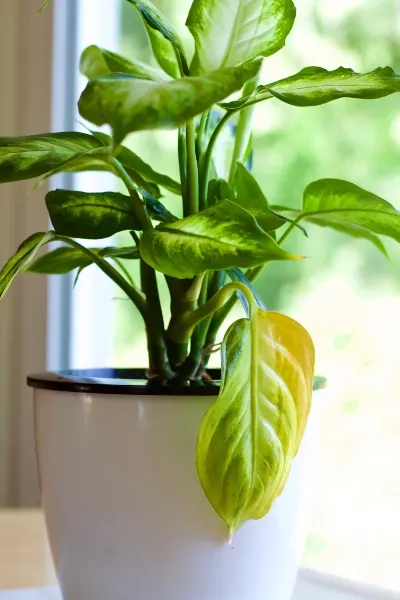
Yellow leaves are often a sign of problems for your plant. Investigate and take corrective action.
What is Happening?
When a leaf is yellowing it is usually signaling some level of distress in your plant. The plant might be facing a problem it cannot solve alone. So it begins prioritizing which parts of its top growth it can support.
The other leaves can no longer be fed. So they yellow, wither and die. This can happen for several reasons. We go into the most common ones.
Part of the houseplant hobby includes learning how to care properly for your plant. We have individual care guides for all the plants we write about so you will know how to properly care for each one. Search this blog to find each plant care guide.
The Contented Plant
Some plants, Like Calatheas, Are very sensitive to the conditions they grow in. Calatheas can show leaf yellowing due to several types of stress other plants, like Neon Pothos or the Jade Plant, can easily weather through.
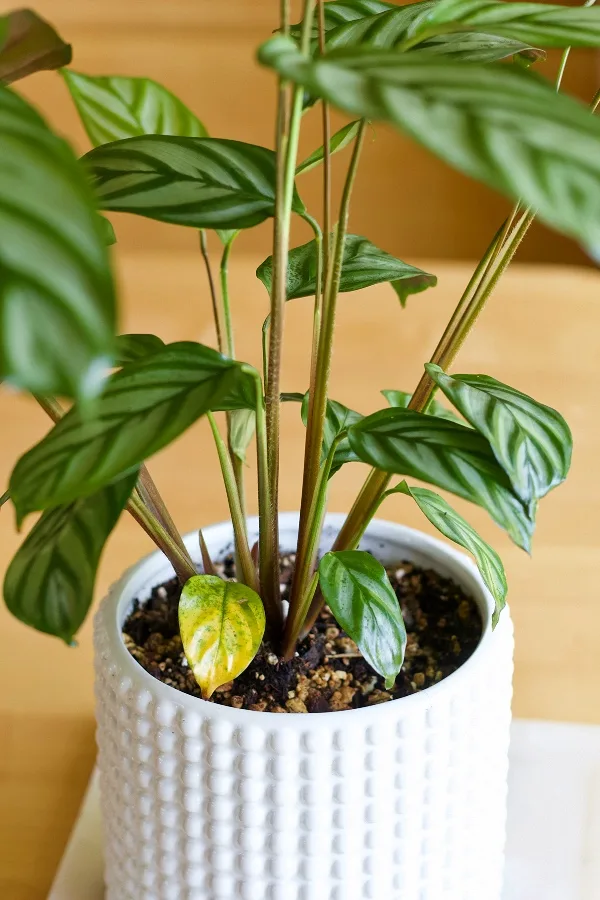
7 Reasons For Yellowing Leaves on Plants.
Here’s the list of common reasons your plants leaves are yellowing and how to help.
- OVERWATERING
- underwatering
- temperature stress
- humidity and draft fluctuations
- Plant Pests
- Fertilizer burn
- Natural leaf drop
Let’s go through them.
1: OVERWATERING
Imagine a HUGE red flashing light on this item. Watering problems account for MOST of the yellowing leaves (or brown crispy leaves) you see on houseplants.
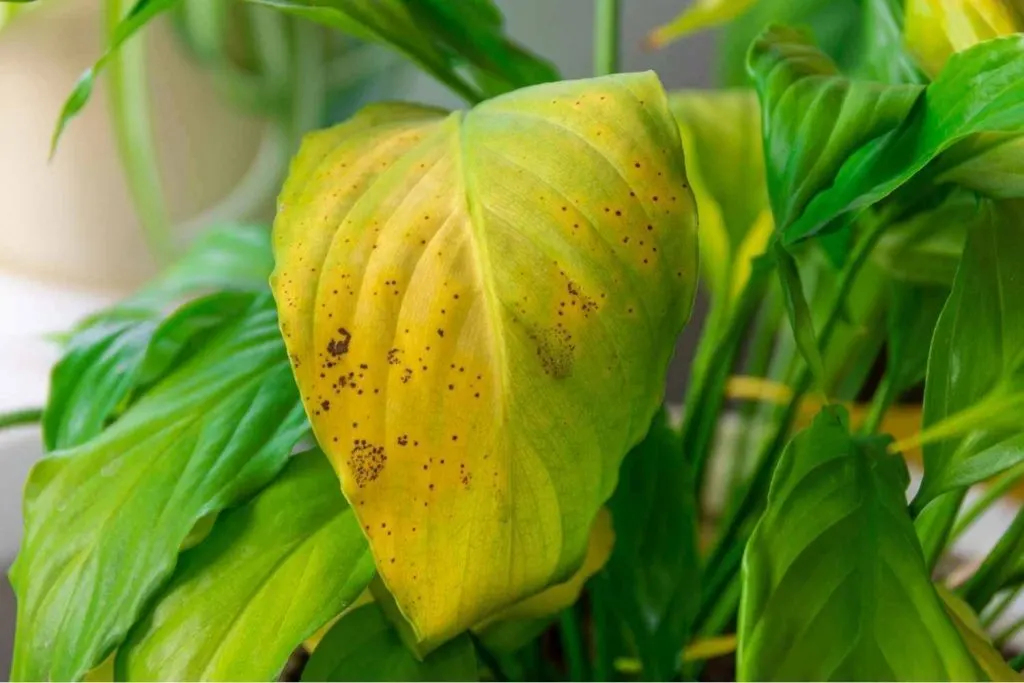
Overwatering is the single biggest problem houseplants have. We love them to death.
The Contented Plant
The problem for plants is balance. Plant roots do need moisture and nutrients. BUT they also need oxygen. When we saturate plant roots for a long period of time we drown them basically.
Some or all of the roots die and rot. As the plant roots die so does the ability to feed the top growth.
The Contented Plant
The red arrow points to one of the leaves of this Arrowhead Plant slowly turning yellow.
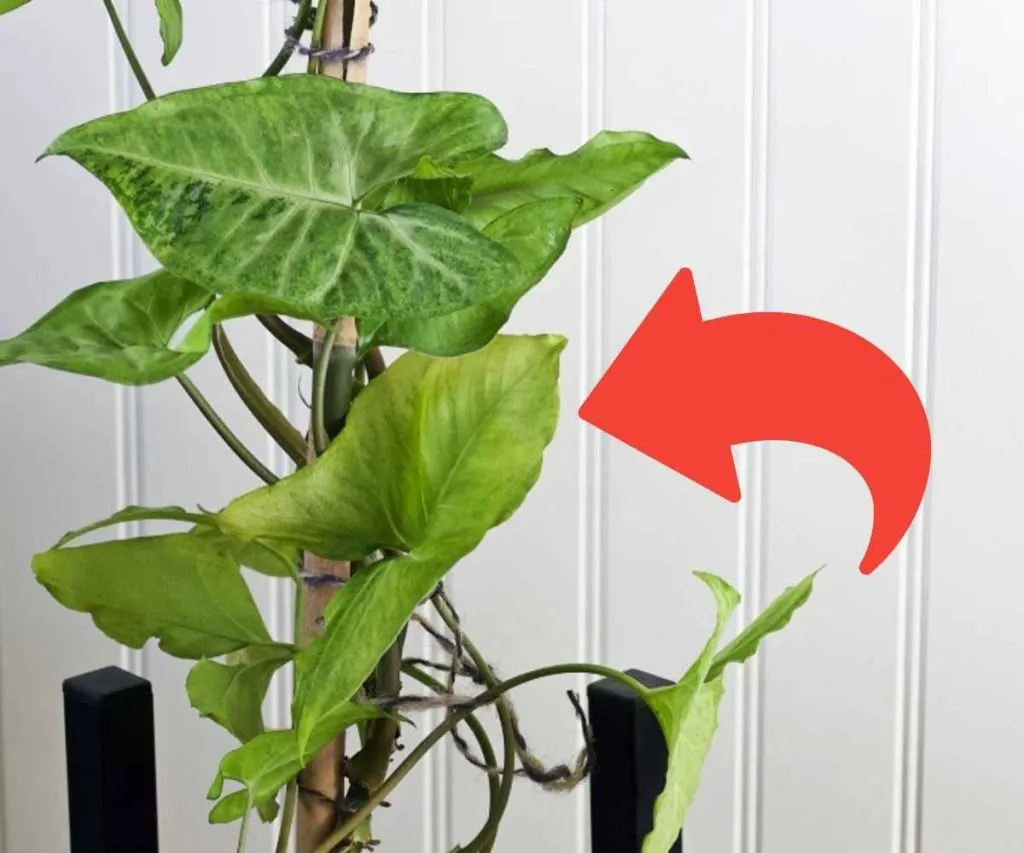
Notice how the leaf has lost the coloring definition and the color is fading and yellowing. Eventually this plant lost many yellowing leaves and died. The root completely rotted off the stem. 🙁
Orchid leaf yellowing can be caused by Orchid Root rot or Orchid Crown rot. Crown rot happens when you water the orchid and water sits in the crevasse in the leaf wells.
Orchid leaves like to lay over and you need to allow the water to fall off the leaves COMPLETELY when you water or better yet, bottom water them to avoid rotting the crown.
Yellow Leaf Tips:
The first sign of watering problems usually shows up in the leaf tips. If you see yellowing leaf tips on your plants review your watering schedule. Is it correct for your plant?
And check your soil! Heavy soils are responsible for LOTS of overwatering problems as are Large plant pots with no drainage. The result is saturated roots that are oxygen deprived.
You can see how yellow tips look on the Calathea Vitatta and Alocasia Bambino below.
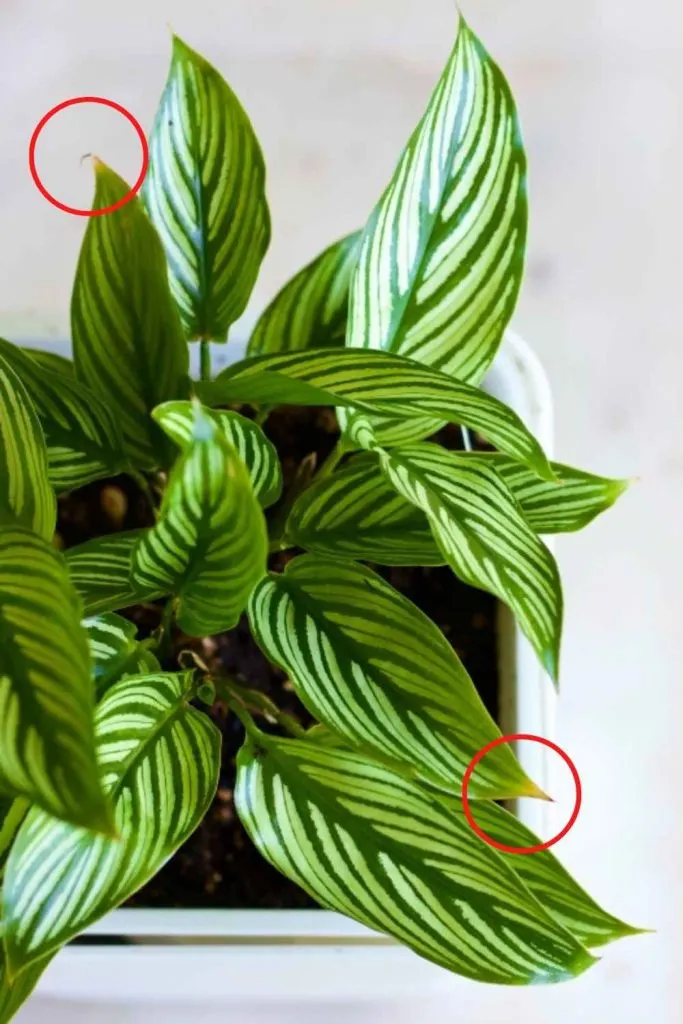
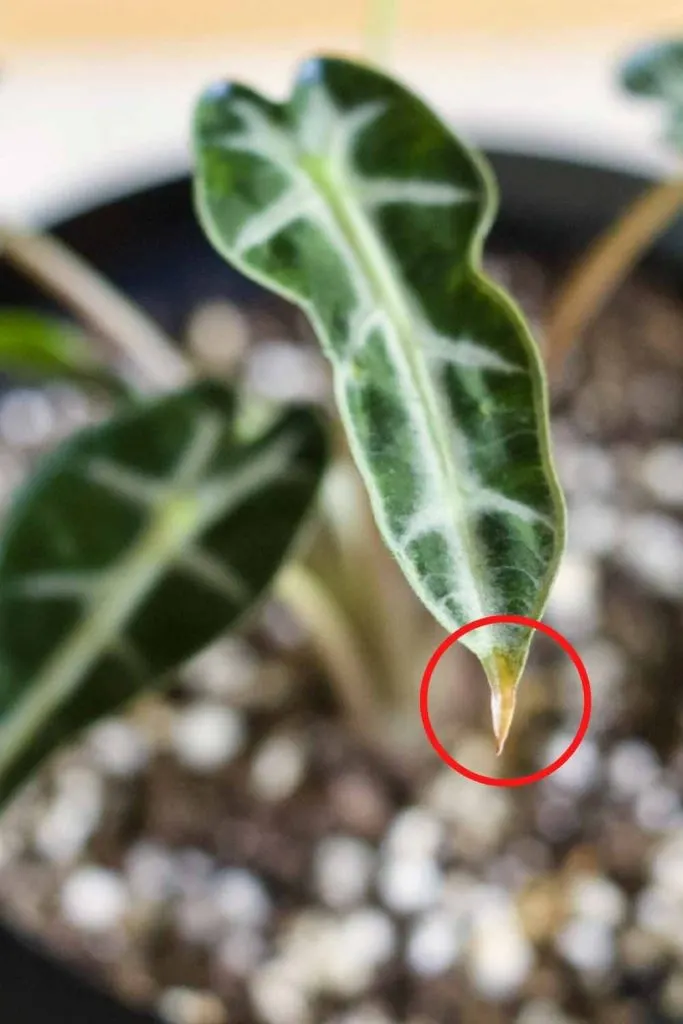
SOME plants are sensitive to the water we use to water our plants. Calatheas are notorious for being very picky about which water you use for them. If you have heavy alkaline or high mineral water the leaf tips may die and curl. Try correcting the water by using distilled water or filtered.
Once the leaves begin to show yellow tips you need to take action. This is a warning from the plant to you.
The cause of yellow leaf tips is most often overwatering, under watering, or using the wrong type of water for your plant.
2: Under watering:
Although overwatering is our most common watering problem under watering also happens. It is especially common in older plants that are root bound and cannot hold water around the roots. The roots cannot drink water or nutrients and begin to die off.
A root bound plant like this spider plant will not accept water well. There is no room in the pot and the soil is most likely degraded. This plant needs new soil and a properly sized, well draining pot.
As you can see the plant is prioritizing the new growth over the older leaves. Fortunately, a repotting, pruning of dead growth and proper watering schedule will revive this spider plant.
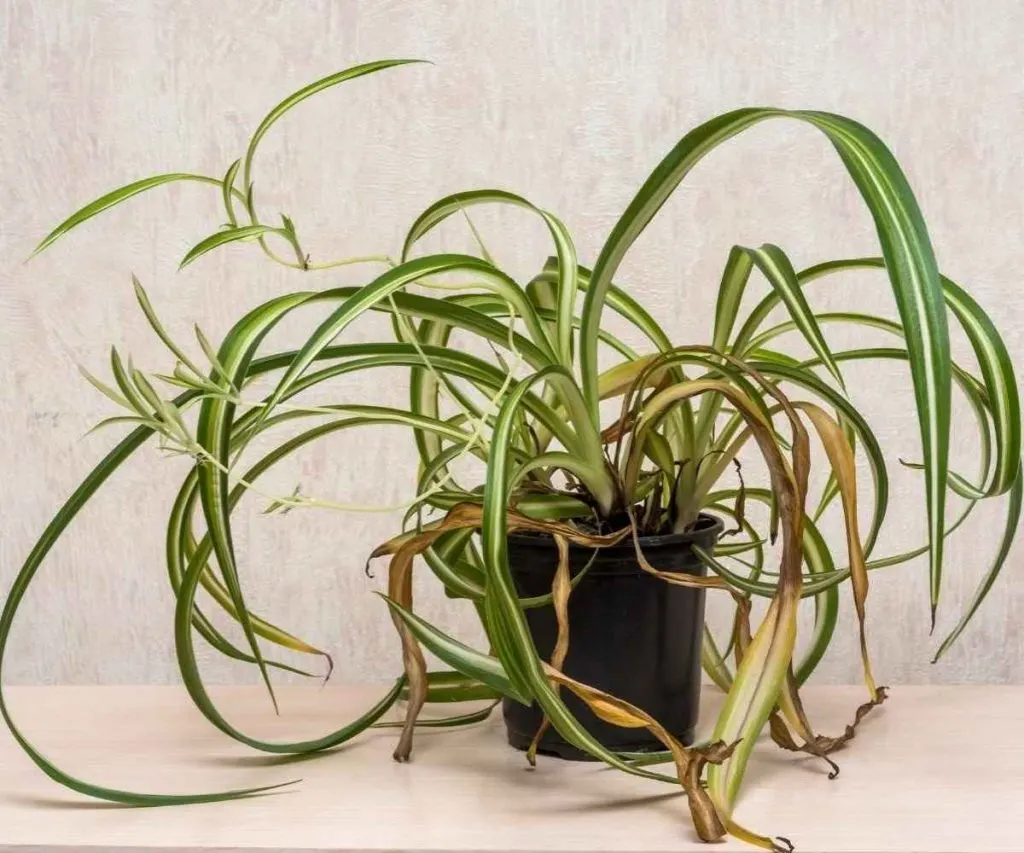
When we Underwater, the leaves get crispy tips and eventually die from the leaf tip to the stem. This happens because the roots are starved of water. Eventually the roots start to die and cannot feed all the top growth.
When the top growth cannot be fed it yellows, browns, gets crispy and eventually dies. If you see this trouble after forgetting about a plant for awhile or coming back from vacation under watering is most likely the culprit.
When roots die of under watering and then you begin watering the plant. The dead roots rot and cause even more problems for your plant.
Inconsistent or underwatering can both cause this trouble.
Watering Solutions:
The plant leaves turning yellow can be an early sign of under watering, watering with the wrong type of water, or over watering.
The solution is a regular watering schedule with the correct water for your plant and an inexpensive moisture meter. Check your plants BEFORE you water them. Know how much water your plant likes and when it wants more water.
If your plant is dying follow the steps above and in our root rot post to fix the problem. Otherwise prune off the dead leaves and water on a better schedule in the future.
Watch! Three common reasons for yellowing leaves and what to do about them.
3: Extreme Temperature Changes:
All plants are susceptible to extreme temperature changes. If you have plants on your outdoor patio or near open windows, or in your greenhouse or sun room be careful of temperature fluctuation and Extremely hot direct light.
Many houseplants can go outside for summer in evenly warm heat. But if you shock them with extreme changes in temperature you will see damage, drooping and yellowing on the leaves.
Most houseplants will tolerate temperatures between 65 and 75 degrees F. with no trouble.
However, If you leave (for example) your Polka Dot plant outside too late in the fall or in the extreme heat of summer it will suffer for sure. It wants shady warm spots outdoors. No direct hot areas or temperatures under 50 degrees F. for this one.
If the roots of ANY plant freeze the plant will yellow, wither and die pretty much without exception. You will see the leaves droop and go yellow if the roots freeze and die.
You might get lucky and save the plant if the roots only partially freeze. Bring the plant inside to warm it and see if it can rebound. You may need to do a root trim, leaf trim and repot with CAREFUL watering to give it the best chance.
4: Humidity and Draft Fluctuations:
When you see crispy dry brown leaf tips this is a sign or under watering or low humidity.
Tropical houseplants enjoy humidity of 40 to 60%. Calatheas are especially sensitive to humidity and they hate drafty places that dry out the leaves or batter them.
Air conditioning, heat vents, open doors, entry ways and windows are all places to avoid with sensitive plants.
If your plant is suffering from drafts just move it away from vents, doorways and drafty windows. This will also help avoid strong temperature fluctuations.
5: Plant Pests:
Pests often cause leaf yellowing in various ways.
Plant pests like spider mites, thrips, aphids , Scale and mealybugs all do leaf damage to your houseplants. Leaf yellowing is one of the signs of pests damage to your plants.
The Contented Plant
This Elephant Ear plant has spider mites. Notice the lighter yellow areas showing through to the leaf top. The mites are most often on the leaf underside in the biggest numbers. They do sucking damage to the leaf.
If you see Plant Leaves Turning Yellow like this check for pests immediately.
The marigold has an advanced case of spider mites. You can see the webbing and the mites. The spider mites have bleached the leaves.
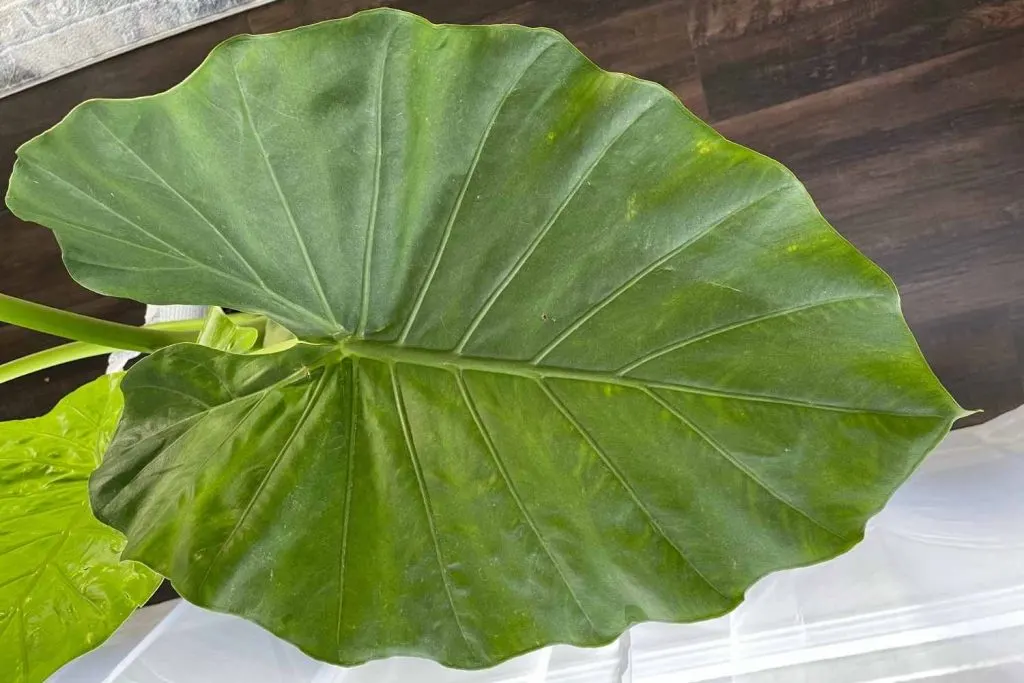
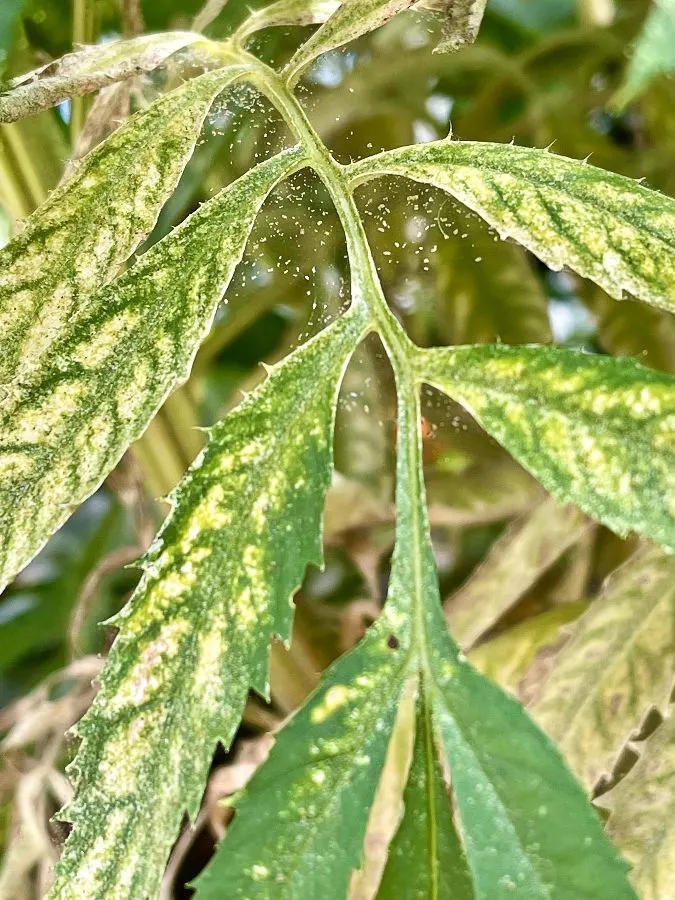
All pests damage your plant. That’s why they live in them. If you see suspicious leaf yellowing be SURE to check for pests and read our guides on how to combat them.
6: Fertilizer Burn:
This is often seen as dry brown patches on the leaf but may be accompanied by leaf yellowing. Especially if you have more than one problem going on.
Incorrectly watered roots over time can have trouble absorbing and distributing nutrients from fertilizers through the leaves. so you may see yellow leaves with dry brown patches.
And if you just over fertilize or use a fertilizer too strong you can damage the roots and have the same result in the long run.
7: When Plant Leaves Turning Yellow is ok:
Natural leaf yellowing and shedding can occur on plants. If the plant appears otherwise healthy and occasionally drops a leaf this may be perfectly normal for your plant.
The Ficus Benjamina normally drops old leaves. It is considered a messy plant. Just clean the leaves off the floor and out of the pot occasionally. However, Remember to make sure the plant is getting a proper environment, feeding, watering and regular pest inspection.
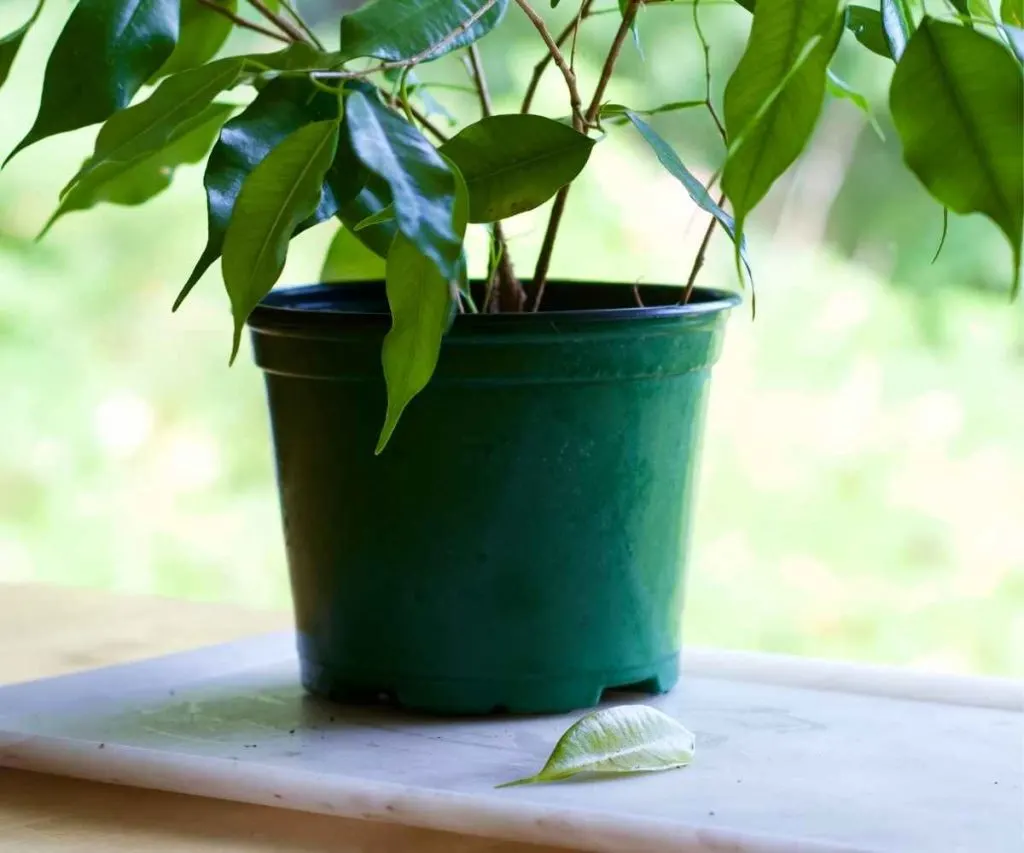
If it drops a LOT of leaves or the leaves go yellow in great numbers, this is not normal.
Ficus Benjamina and the Money Tree will both occasionally drop leaves when they are healthy.
Some plants like these don’t like being moved about. If you have recently purchased one of these or a Fiddle Leaf Fig , or moved them to a new location in your home you may see some normal leaf drop.
Another reason for leaf yellowing and leaf drop: As plant leaves age they will eventually go yellow and die. this is a normal process and does no harm to the plant. If you have an old leaf with over 50% yellowing, prune it off to encourage the newer growth.
Now keep an eye on your plant, and make sure no problems exist.
Summary:
Overwatering is the most common reason for yellowing leaves on plants. However, you need to be familiar with your plants particular needs and make sure you provide the pot type, proper feeding and watering schedule, soil conditions and lighting as well.
Keep an eye out for plant pests and treat them quickly when you find them.
Our plant care guides will help you learn more about how to take best care of your plants. If you see a problem, fix it quickly. Yellowing leaves is not always serious but can mean the death of the plant if not properly diagnosed.
Related Content:
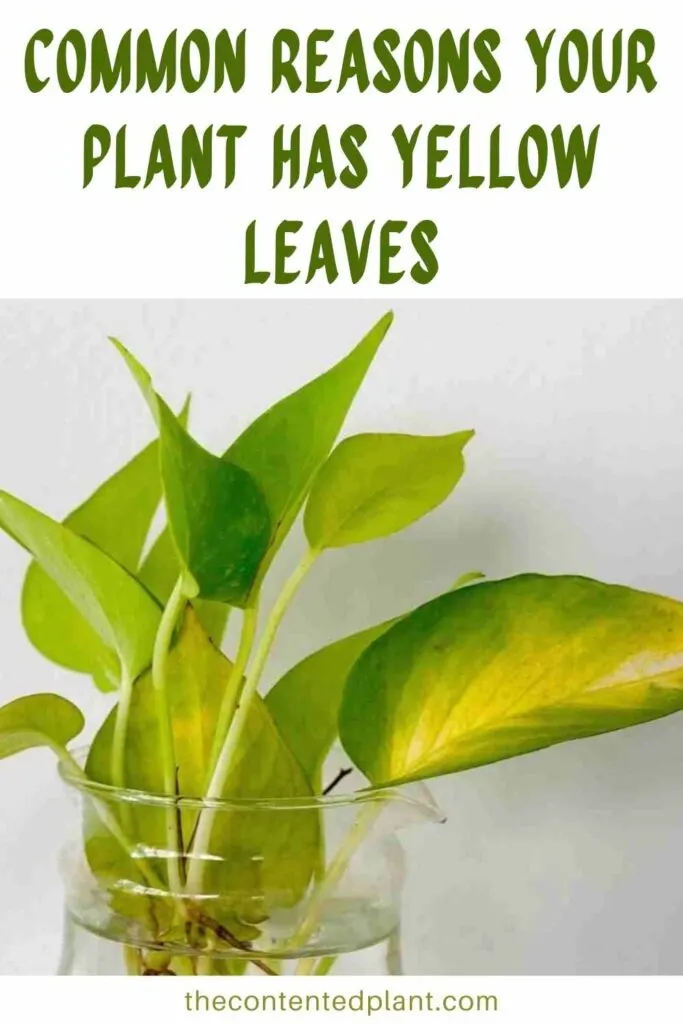
Follow Us:
Find us on YouTube, Instagram , Pinterest and TikTok! We love to Plant chat. We also comment, like and occasionally share your content to our daily stories. We’d love to see your plants. Share your joy in your houseplants. Happy Planting!
Recent Posts:
Further reading on Why plants turn yellow Ambius.com

How to Water Plants & Flowers in Pots - GardeningIsLife Blog
Saturday 5th of August 2023
[…] Leaves-Read our post on Seven Reasons Your Plant Has Yellowing leaves for more on yellowing […]
Pink Princess Philodendron - The Contented Plant
Monday 1st of August 2022
[…] Water regularly and keep the soil evenly, lightly moist to slightly dry. Thoroughly soak the soil occasionally to allow excess salts to flush out. Drain soil very well. Constant overwatering causes root rotunda encourages fungus gnats. Inconsistent watering can cause yellowing leaves. […]
The Best Snake Plant Soil Mix - The Contented Plant
Wednesday 27th of April 2022
[…] our posts on Seven Reasons Your Plant has Yellowing Leaves for more ideas on why your plant has yellowing […]
Murdannia Loriformis-The Bright Star Plant - The Contented Plant
Thursday 14th of April 2022
[…] Yellowing leaves. indicates overwatering- Find out about 7 Reason for yellowing leaves on plants in this post. […]
Mold On Plant Soil-Is it harmful? How to Kill It - The Contented Plant
Sunday 6th of March 2022
[…] your plants healthy? OR are Drooping yellowing leaves a problem for some of your plants with moldy […]